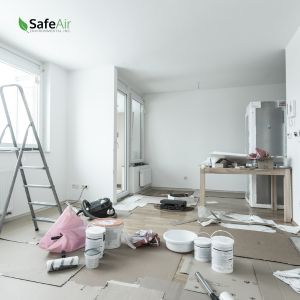How Renovations and Remodelling Affect Indoor Air Quality
Posted in Air Quality, on August 13, 2024
Are you planning a renovation this season? If you’re remodeling or renovating any part of your home, the team at SafeAir recommends adding home air quality testing to your workflow. This science-based service is helpful for identifying allergens, particulates, gasses, or other air pollution created or stirred up during the renovation process. Air quality testing in Toronto is also beneficial before renovations, especially if asbestos or mold is present, since an early warning will help you and your contractor stay safe.
What is Average Air Quality?
 In a society that values exceptionalism, average isn’t good enough, especially when it comes to indoor air quality. At SafeAir, we test for and help homes achieve exceptional air quality ratings. Healthy results in the world of home air quality testing mean your home is:
In a society that values exceptionalism, average isn’t good enough, especially when it comes to indoor air quality. At SafeAir, we test for and help homes achieve exceptional air quality ratings. Healthy results in the world of home air quality testing mean your home is:
- Within or under safe ranges for VOCs or gasses
- Has balanced humidity and temperature
- Is free from mold, radon, or asbestos particles
- Has no carbon monoxide or other particles caused by combustion
- Is free from allergens like pollen, moulds, mites etc.
Symptoms of Poor Indoor Air Quality
How do you tell if your home has poor air quality? Often, there are few visible signs or symptoms that your home has issues related to air quality. The lucky few who detect an odour know it’s time to call us for testing, but if there’s no smell, watch out for symptoms like:
- High humidity
- Condensation on walls or windows
- Poor airflow
- Visible mold growth
- Thermostat regulation problems
- Chronic respiratory issues
- Poor sleep
- Poor skin or hair quality
- Headaches
Special Air Quality Considerations During Renovation
When you’re planning on re-doing your kitchen or putting in a second bathroom, average air quality goes out the window. Renovations can cause considerable changes to your home’s indoor environment and without proper precautions before, during, or after, your health and wellness can suffer. Some of the things that the SafeAir team considers include:
Asbestos
In homes built before the 90s, asbestos fibres in flooring, ceilings, and insulation is a genuine concern. Asbestos is safe until it’s disturbed — and nothing disturbs those tiny fibres like demolition and removal! Testing products for asbestos before you begin is critical — it helps you and your reno team put in the proper safety precautions to eliminate your risk of exposure.
Mold
Locating a mold colony or identifying a problem with moisture before you finish your renovations can help you avoid costly (and stressful) re-dos. The best weapon against mold growth is prevention, and SafeAir can help with suggestions for improving airflow and avoiding humidity.
Dust and Debris
There’s always demolition, sanding, or cutting that happens during renovations, and this will all contribute dust and debris to the environment. Small particles can easily become lodged on your skin or in your eyes, nose, or respiratory system, causing irritation or illness. Preparing for these inevitabilities and monitoring the levels post-renovation can help you put into place filtration or mitigation methods where necessary.
Glues, Paints, and VOCs
Remodelling usually involves paint, solvents, glues, and other chemicals that may off-gas or create fumes that irritate the body. Proper air filtration and exchange are essential for the periods in which these activities take place, but also in the days following as materials complete their off-gassing.
Strategies for Before, During, and After Renovation
In our opinion, air quality testing in Toronto has value at any stage of renovation. We will help you identify weak spots and problem areas that need extra attention and help you devise strategies for reducing exposure and risk as the work progresses. After your renovation is complete, home air quality testing is beneficial for clean-up, as well as any off-gassing or unexpected changes. To book your air quality test in Toronto, contact the SafeAir team to learn more.

